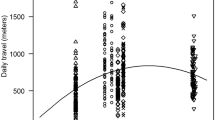Abstract
The grasshopper, Schistocerca americana, grew better on a mixture of cotton and kale than on either alone. When the two foods were placed in close proximity, growth rates were similar among individuals, but when they were 20 cm apart growth rates were extremely variable among individuals. Behavioral analyses showed that distance influenced the dietary mixing behavior of individuals. Foods close together were sampled more often and there were more meals that included both food types. When foods were distant, individuals tended to stay for relatively long periods at one or the other; when on cotton, this resulted in more feeding on cotton, which was an inferior food. Individuals varied in the extent to which they were constrained by the distance between the two foods. Those that moved between the foods less and therefore mixed less seemed to grow less well, suggesting the possibility of a trade-off between active foraging and behavior associated with predator avoidance.
Similar content being viewed by others
REFERENCES
Barnes, O. L. (1955). Effects of food plants on the lesser migratory grasshopper. J. Econ. Entomol. 48: 119–124.
Bernays, E. A., and Bright, K. L. (1993). Dietary mixing in grasshoppers: A review. Comp. Biochem. Physiol. 104A: 125–131.
Bernays, E. A., and Raubenheimer, D. (1991). Dietary mixing in grasshoppers: Changes in acceptability of different plant secondary compounds associated with low levels of dietary protein. J. Insect Behav. 4: 545–556.
Bernays, E. A., Bright, K. L., Howard, J. J., Raubenheimer, D., and Champagne, D. (1992). Variety is the spice of life: Frequent switching between foods in the polyphagous grasshopper Taeniopoda eques Burmeister (Orthoptera: Acrididae). Anim. Behav. 44: 721–731.
Bernays, E. A., Bright, K. L., Gonzalez, N., and Angel, J. E. (1994). Dietary mixing in grasshoppers: Tests of two hypotheses. Ecology 75: 1997–2006.
Chambers, P., Simpson, S. J., and Raubenheimer, D. (1995). Behavioural mechanisms of nutrient balancing in Locusta migratoria nymphs. Anim. Behav. 50: 1513–1523.
Chambers, P., Sword, G., Angel, J. E., Behmer, S., and Bernays, E. A. (1996). Foraging by generalist grasshoppers: Two different strategies. Anim. Behav. 52: 155–165.
Champagne, D., and Bernays, E. A. (1991). The importance of an inadequate sterol profile in food aversion learning in grasshoppers. Physiol. Entomol. 16: 391–400.
Chapman, R. F., and Sword, G. A. (1994). The relationship between plant acceptability and suitability for survival and development of the polyphagous grasshopper, Schistocerca americana (Orthoptera: Acrididae). J. Insect Behav. 7: 411–431.
Freeland, W. J. (1975). Feeding behaviour of the Australian acridid Valanga irregularis. Entomol. Exp. Appl. 18: 281–289.
Freeland, W. J., Calcott, P. H., and Anderson, L. R. (1985). Tannins and saponin: Interaction in herbivore diets. Biochem. Syst. Ecol. 13: 189–193.
Hodge, C. (1933). Growth and nutrition of Melanoplus differentialis. 1. Growth on a satisfactory mixed diet and on diets of single food plants. Physiol. Zool. 6: 306–328.
Kaufmann, T. (1965). Biological studies on some Bavarian Acridoidea (Orthoptera) with special reference to their feeding habits. Ann. Entomol. Soc. Am. 58: 791–801.
Lima, S. L., and Dill, L. M. (1990). Behavioral decisions made under the risk of predation: A review and prospectus. Can. J. Zool. 68: 619–640.
MacFarlane, J. H., and Thorsteinson, A. J. (1980). Development and survival of the twostriped grasshopper, Melanoplus bivittatus (Say) (Orthoptera: Acrididae), on various single and multiple plant diets. Acrida 9: 63–76.
Noldus, L. P. J. J. (1991). The Observer: A software system for collection and analysis of observational data. Behav. Res. Meth. Instr. Comput. 23: 415–429.
Pfadt, R. E. (1949). Food plants as factors in the ecology of the lesser migratory grasshopper Melanoplus mexicanus. Bull. Wy. Expt. Stat. No. 290.
Pickford, R. (1962). Development, survival and reproduction of Melanoplus bilituratus reared on various food plants. Can. Entomol. 94: 859–869.
Raubenheimer, D., and Bernays, E. A. (1993). Feeding patterns and dietary mixing in the polyphagous grasshopper Taeniopoda eques: A field study. Anim. Behav. 45: 153–167.
Sih, A. (1993). Effects of ecological interactions on forager diets: Competition, predation risk, parasitism and prey behaviour. In Hughes, R. N. (ed.), Diet Selection: An Interdisciplinary Approach to Foraging Behaviour, Blackwell, Oxford, pp. 182–212.
Simpson, S. J. (1990). The pattern of feeding. In Chapman, R. F., and Joern, A. (eds.), Biology of Grasshoppers, Wiley Interscience, New York, pp. 73–104.
Wilson, D. S., Clark, A. B., Coleman, K., and Dearstyne, T. (1994). Shyness and boldness in humans and other animals. TREE 9: 442–446.
Author information
Authors and Affiliations
Rights and permissions
About this article
Cite this article
Bernays, E.A., Angel, J.E. & Augner, M. Foraging by a Generalist Grasshopper: The Distance Between Food Resources Influences Diet Mixing and Growth Rate (Orthoptera: Acrididae). Journal of Insect Behavior 10, 829–840 (1997). https://doi.org/10.1023/B:JOIR.0000010416.54387.44
Issue Date:
DOI: https://doi.org/10.1023/B:JOIR.0000010416.54387.44




